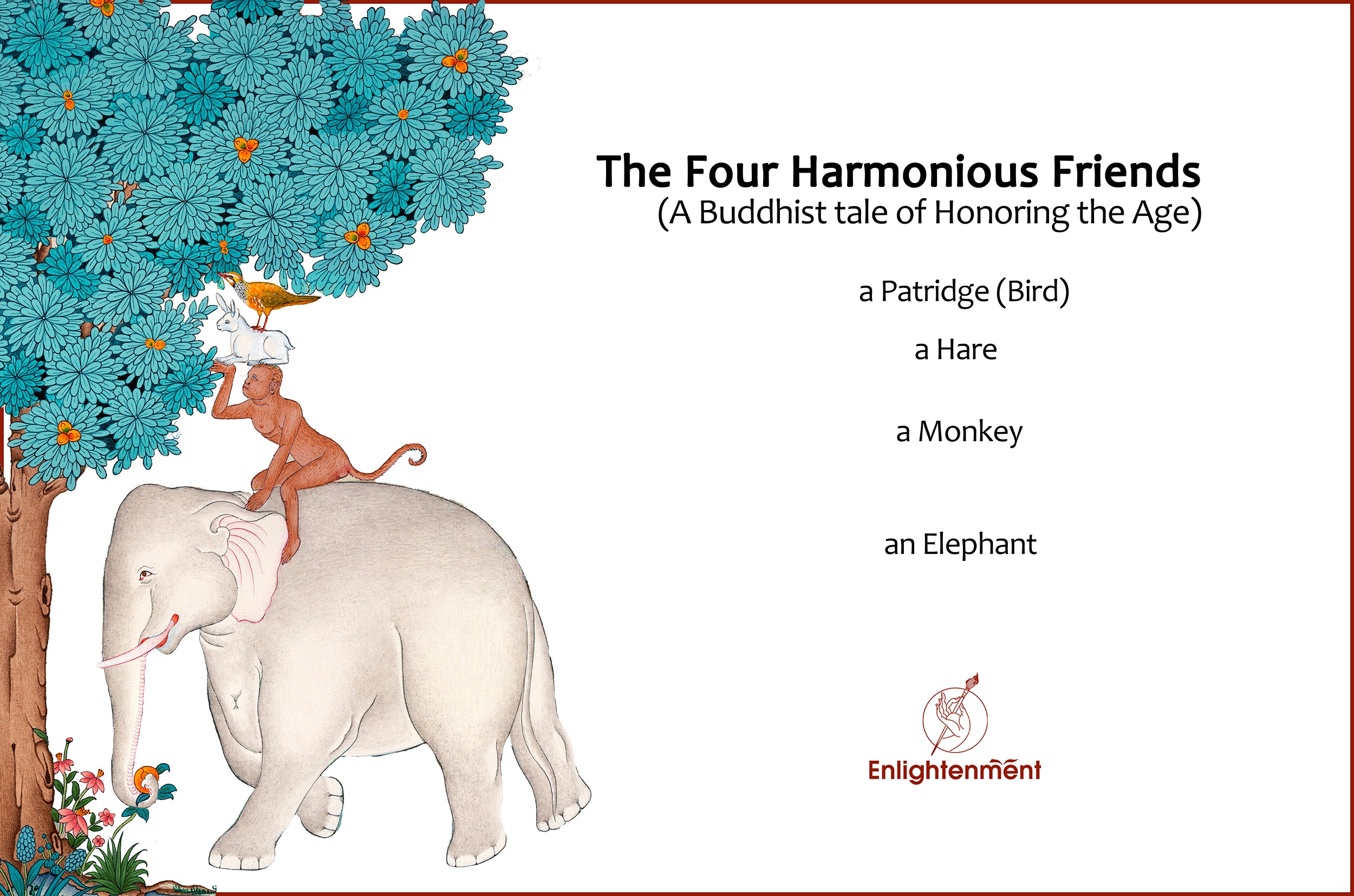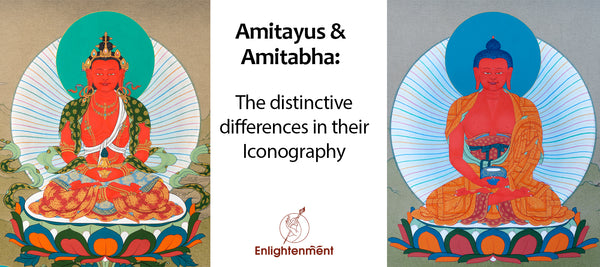Who are the Four Harmonious friends?
The tale of the four harmonious animals or harmonious brothers/ friends is one of the widely preached Jataka tales, a significant part of Buddhist Mythology. The tale can be seen in many Bhutanese and Tibetan art. Especially on visiting monasteries and stupas. Practitioners often have a carving of the four harmonious friend's patterns as a decorative pattern on their utensils.
It is believed that Buddha Shakyamuni told the tale of four harmonious friends showcasing the importance of respecting the elders. The Vinayavastu, a Tibetan Buddhist scripture included in the first section of the Kangyur, is most likely the story's primary source.
The Delightful Tale of Honoring the Age
In the forest, four special animals were all close friends: a partridge, a hare, a monkey, and an elephant. They lived beneath a large banyan tree. Out of curiosity, they wanted to figure out who was the old among them. So, to figure out who was the most senior, they started talking about the age of the oldest banyan tree where they lived.
The elephant remarked, "When I first saw this tree, it was as big as my body." "When I arrived, the tree was as big as my body," the monkey remarked. The hare remarked, "I licked the dew from this tree's leaves when it was still just a sprout when I first saw it." The partridge claimed, "I carried a seed here, fertilized it, and planted this tree."
Thus, their approximate ages were determined using this tree. The youngest animals sat below the older ones out of respect for the elders, with the oldest at the top.
A Different Perspective of the Same Story:
There is also a different version of the story. Initially, the bird carried the seed and planted the tree. Due to its inability to fly, the bird could only scratch for food when the tree was just a plant in the ground. But as it grew, he needed the rabbit's assistance to get to the food. The bird perched on the rabbit's back so it could reach the growing tree while the rabbit consumed the food on the ground. The monkey climbed the tree to drop fruit for the other animals to eat on the ground, but he couldn't get to the upper branches, so the two animals needed his assistance as the tree grew. Ultimately, they required the aid of the elephant, who could procure food for the smaller animals by climbing to the tree's uppermost branches. Even though the bird is the eldest, the narrative shows that he is not ashamed to seek assistance.
The bird, as being the eldest, taught young ones about the values and morals of life. He educated others about not doing wrongdoings such as taking lives, use of deceptive words, consumption of intoxicants, and sexual misconduct.
The Buddha stated that Shariputra was a monkey, his teacher Maudgalyayana was an elephant, and the Buddha himself had previously existed as a bird. This fable included the hare, also known as Ananda, the Buddha's oldest student. As a result of being the second person to recognize the tree while it was a leafless sapling, Ananda was given the position of seniority. Therefore, seniority would be determined by age. According to the Vinaya teaching, 'Dülwa rlung,' and the discourse 'Do de nä kyang rlung,' the pheasant represented the competent destroyer who had transcended Shakyamuni Buddha.
Honoring the Age: Tibetan Thangka of The Four Harmonious Friends This Thangka of the four harmonious friends represents the narrative that conveys valuable life lessons about peace, interdependency, and co-existence. The animals are depicted in two different ways: 'segregated into their respective habitats on the one hand and joined in harmonic collaboration on the other.' The master artist with decades of experience has beautifully painted this thangka with much precision on all the iconographic details.
This Thangka of the four harmonious friends represents the narrative that conveys valuable life lessons about peace, interdependency, and co-existence. The animals are depicted in two different ways: 'segregated into their respective habitats on the one hand and joined in harmonic collaboration on the other.' The master artist with decades of experience has beautifully painted this thangka with much precision on all the iconographic details.
Moral of the story
This story depicts the importance of peace, dependency, cooperation, and friendship. Each individual could feed due to their nature of helping one another. None of the animals were envious or concerned about not getting food for themselves. They all were willing to help one another despite their difference in size and ability to aid.
In the end, they all could help one another as they worked in unison and in harmony. The willingness to help and receive help is the critical factor here.
Although the elephant may deserve the highest respect due to its size and might, the tiny bird maintains this place due to its seniority. Therefore, the moral lesson that this story aims to teach is that respect for one another based on age, as a barometer of one's experiences in life, can be accomplished through communal peace.
However, people have often argued that seniority-based respect is not necessarily the most accurate indicator of a person's morals or intelligence. Respect is determined more by how long a person has been ordained as a monk than by their actual age, particularly in the world of monastic life. Additionally, respect must be won on both sides. This is evaluated spiritually based on one's development in the Dharma's practice and the accrual of merits. The ability of the four species to live in harmony, cooperate, and enjoy the fruits of their labors implies that both young and old can benefit from one another.
To sum up, the four harmonious friends is a straightforward story rich in virtues, including unity, selflessness, generosity, respect, care for the environment and nature, and friendship. It has stood the test of time and is beloved by many, particularly Bhutanese.
In terms of a symbol interpretation of this magnificent narrative, the elephant represents our physical body, the monkey for our wandering mind, the rabbit for our emotions, and the bird for our soul.
These four harmonious animals depict the four terrestrial habitats: sky (bird), tree (monkey), ground (elephant), and underground (hare). The banyan tree is known for its fruit-bearing tree. Shakyamuni Buddha related this entire story to the 'Tittira Jakata' parable of "Honoring of Age."



1 comment
Carlos Delgado Torres
This is a lovely story, very valid for this days in which, older are getting overpassed and undervalued.
Thanks for sharing!
Adios amigos!
Carlos